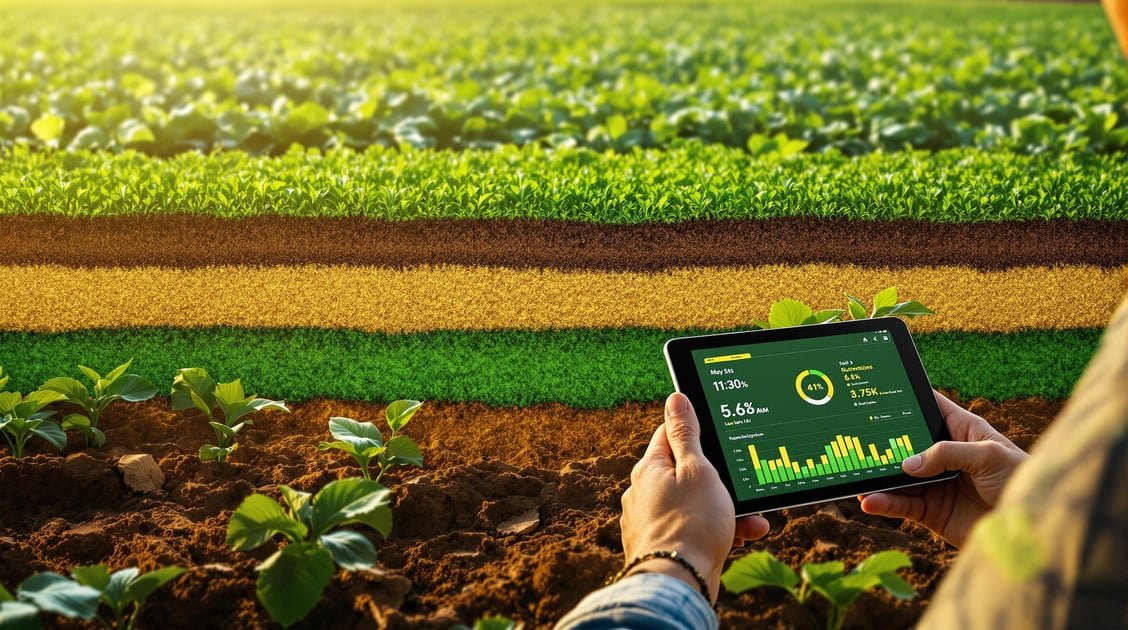How AI Predicts Soil Nutrient Depletion

AI can now predict how your garden's soil nutrients like nitrogen, phosphorus, and potassium will change over time. This helps you fertilize only when needed, saving money and preventing plant stress. By combining real-time soil sensor data, weather patterns, and plant nutrient uptake, tools like AIGardenPlanner forecast nutrient trends with high accuracy.
Key Benefits:
- Reduce Fertilizer Waste: Apply nutrients only when necessary.
- Prevent Crop Stress: Address deficiencies before visible damage occurs.
- Save Money: Optimize fertilizer use and lower maintenance costs.
- Tailored Plans: Get custom schedules for fertilization and planting.
AI uses soil sensors, satellite imaging, and machine learning to analyze patterns and predict nutrient depletion. Tools like AIGardenPlanner start at $19/month, making this technology accessible for all gardeners. Ready to improve your garden care? AI makes it easier than ever.
Dimitra Technical Series: Data Collection & AI

AI Soil Data Analysis Methods
Modern AI systems combine various data sources to predict soil nutrient loss, enabling more effective garden planning.
Soil Sensors and Real-Time Data
Soil sensors provide live updates on critical metrics like moisture, pH, and nutrient levels. This real-time data helps gardeners make immediate adjustments to improve soil health and plant growth.
Aerial and Satellite Imaging
Aerial and satellite imagery offer a broader perspective on soil conditions. These tools identify vegetation patterns and soil changes that may signal nutrient deficiencies. When combined with on-the-ground measurements, this data creates a more complete picture of soil health, especially across larger garden areas. Machine learning can then process these layers of information to reveal actionable insights.
Machine Learning in Soil Analysis
AI-powered systems process and analyze soil data by:
- Standardizing input data for consistency
- Detecting patterns in soil conditions
- Predicting future nutrient levels
As these systems gather more seasonal data, their accuracy improves, allowing gardeners to make faster, more precise decisions about fertilization and soil management.
3 Steps of AI Nutrient Prediction
AI technology simplifies the process of predicting soil nutrient depletion, turning raw data into practical advice for garden care. Here's how it works:
Collecting and Combining Data
AI gathers data from various sources to build a detailed soil profile:
- Real-time sensor readings: Capturing current soil conditions.
- Location data: Including climate zones and weather trends.
- Historical soil tests: Offering insights into past nutrient levels.
- Visual data: Such as aerial images of vegetation and soil.
This data is standardized so it can be compared effectively. By combining these inputs, AI identifies underlying trends in soil health.
Identifying Soil Patterns
Using advanced algorithms, AI analyzes the collected data to find patterns and connections in soil nutrient levels. It examines:
- Seasonal changes in nutrient availability.
- Weather effects on soil composition.
- Interactions between different nutrients.
- How past fertilization impacts current soil health.
Machine learning helps pinpoint subtle trends that might be missed through manual observation. These insights are key to creating accurate nutrient forecasts.
Generating Predictions and Plans
With these patterns in hand, AI provides detailed forecasts about nutrient depletion. These predictions are used to:
- Suggest the best times to apply fertilizers.
- Recommend plants suited to current soil conditions.
- Develop schedules for ongoing garden maintenance.
The system continuously improves its predictions by incorporating new data.
AIGardenPlanner (https://aigardenplanner.com) uses this approach to deliver customized garden plans based on your soil and climate. For instance, if the AI identifies a nitrogen deficiency during peak growing months, it might recommend nitrogen-fixing plants or a specific fertilization schedule. These tailored suggestions not only improve soil health but also reduce unnecessary fertilizer use, saving time and money.
sbb-itb-4d6a8dd
🚀 Ready to Reinvent Your Garden?
Join thousands of homeowners who have transformed their gardens using our AI design tool. Upload one photo to explore endless possibilities.
Get your AI garden designs →AI Benefits for Garden Care
AI is changing the way we care for gardens by offering quicker analysis and tailored nutrient suggestions.
Quick and Accurate Analysis
With real-time sensor data, AI can quickly pinpoint nutrient deficiencies in your soil. This allows you to adjust your care routines immediately, saving time and ensuring your plants get exactly what they need. Plus, it helps cut down on unnecessary resource use, which means spending less overall.
Reducing Fertilizer Waste
AI's soil-specific recommendations help avoid over-fertilizing your garden. By applying only what’s needed, you not only save money but also reduce the impact on the environment.
Cutting Garden Expenses
Smarter nutrient management means less waste and lower overall costs. Tools like AIGardenPlanner, available for as little as $19 per month, make this technology accessible for gardeners of all levels.
Current Limits and Next Steps
AI has shown it can predict nutrient trends effectively, but there are still hurdles to clear and opportunities to explore.
Data Gaps and Quality Issues
Even with progress, achieving reliable and comprehensive soil data remains a challenge. Efforts are now focused on addressing the natural differences in garden soils to make predictions more accurate. Meanwhile, affordable digital tools are beginning to transform how people approach garden planning.
Cost and Ease of Use
Affordable digital tools are changing the game for garden planning. For example, AIGardenPlanner offers subscription plans starting at just $19 per month, eliminating the need for pricey equipment. Beyond being budget-friendly, these tools continue to improve by adding new features and capabilities.
New AI Soil Tools
AI-powered garden planning tools are becoming increasingly sophisticated. AIGardenPlanner now creates custom designs tailored to local climate conditions, individual gardening goals, and personal preferences. Each plan uses 5 Generation Tokens to produce detailed growing guides and maintenance schedules, pushing garden care into a new era of precision and convenience.
Summary
AI is reshaping the way we manage garden nutrients. By using advanced data analysis and machine learning, these tools provide highly accurate forecasts for seasonal nutrient needs and help create tailored garden plans.
Take AIGardenPlanner, for example. This platform combines AI-driven soil analysis with personalized garden designs. Its AI Plant Advisor uses local climate and soil data to craft custom growing guides and maintenance schedules, making gardening more efficient and effective.
Subscribers gain access to personalized recommendations through budget-friendly plans, showcasing how AI is changing garden planning for the better.
New AI tools are also tackling nutrient depletion by predicting and addressing issues before they arise, ensuring healthier plants and smarter resource use.
As AI evolves, garden planning will become even more precise and personalized. Platforms like AIGardenPlanner are blending modern technology with gardening traditions, paving the way for more productive and sustainable gardens.
Related posts
Related Articles

How AI Improves Weather-Based Irrigation
AI irrigation systems optimize watering by using real-time weather and soil data, ensuring water savings and healthier plants.

Checklist for Zen Garden Structure Maintenance
Explore essential maintenance tasks to preserve the serene beauty of your Zen garden, ensuring its tranquility and vibrant health.

Professional Garden Design: Common Questions Answered
Explore how professional garden design enhances outdoor spaces, incorporating AI tools, trends, and cost insights for a beautiful, functional garden.

How AI Detects Soil Nutrient Deficiencies
AI revolutionizes soil analysis by quickly detecting nutrient deficiencies, providing insights that enhance gardening and farming practices.

Top 5 Free Landscape Design Software for Mac
Looking for the best free landscape design software for Mac? Check out our list of top 5 options, including SketchUp Free, SmartDraw, and Sculptmydream.

5 Machine Learning Models for Frost Forecasting
Explore five machine learning models for accurate frost forecasting, helping protect crops and optimize planting schedules.